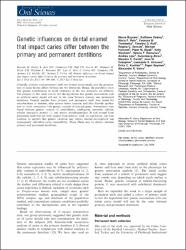Genetic influences on dental enamel that impact caries differ between the primary and permanent dentitions

Göster/
Erişim
info:eu-repo/semantics/openAccessTarih
2015Yazar
Bayram, MerveDeeley, Kathleen
Reis, Maria
Trombetta, Vanessa
Ruff, Timothy
Sencak, Regina
Hummel, Michael
Dizak, Piper
Washam, Kelly
Romanos, Helena
Lips, Andrea
Alves, Gutemberg
Costa, Marcelo
Granjeiro, Jose
Antunes, Leonardo
Kuechler, Erika
Seymen, Figen
Vieira, Alexandre
Üst veri
Tüm öğe kaydını gösterKünye
Bayram, M., Deeley, K., Reis, M., Trombetta, V., Ruff, T., Sencak, R. ... Vieira, A. (2015). Genetic influences on dental enamel that impact caries differ between the primary and permanent dentitions. European Journal of Oral Sciences, 123(5), 327-334. https://dx.doi.org/10.1111/eos.12204Özet
Clinically, primary and permanent teeth are distinct anatomically and the presentation of caries lesions differs between the two dentitions. Hence, the possibility exists that genetic contributions to tooth formation of the two dentitions are different. The purpose of this study was to test the hypothesis that genetic associations with an artificial caries model will not be the same between primary and permanent dentitions. Enamel samples from primary and permanent teeth were tested for microhardness at baseline, after carious lesion creation, and after fluoride application to verify association with genetic variants of selected genes. Associations were found between genetic variants of ameloblastin, amelogenin, enamelin, tuftelin, tuftelin interactive protein 11, and matrix metallopeptidase 20 and enamel from permanent teeth but not with enamel from primary teeth. In conclusion, our data continue to support that genetic variation may impact enamel development and consequently individual caries susceptibility. These effects may be distinct between primary and permanent dentitions.

















